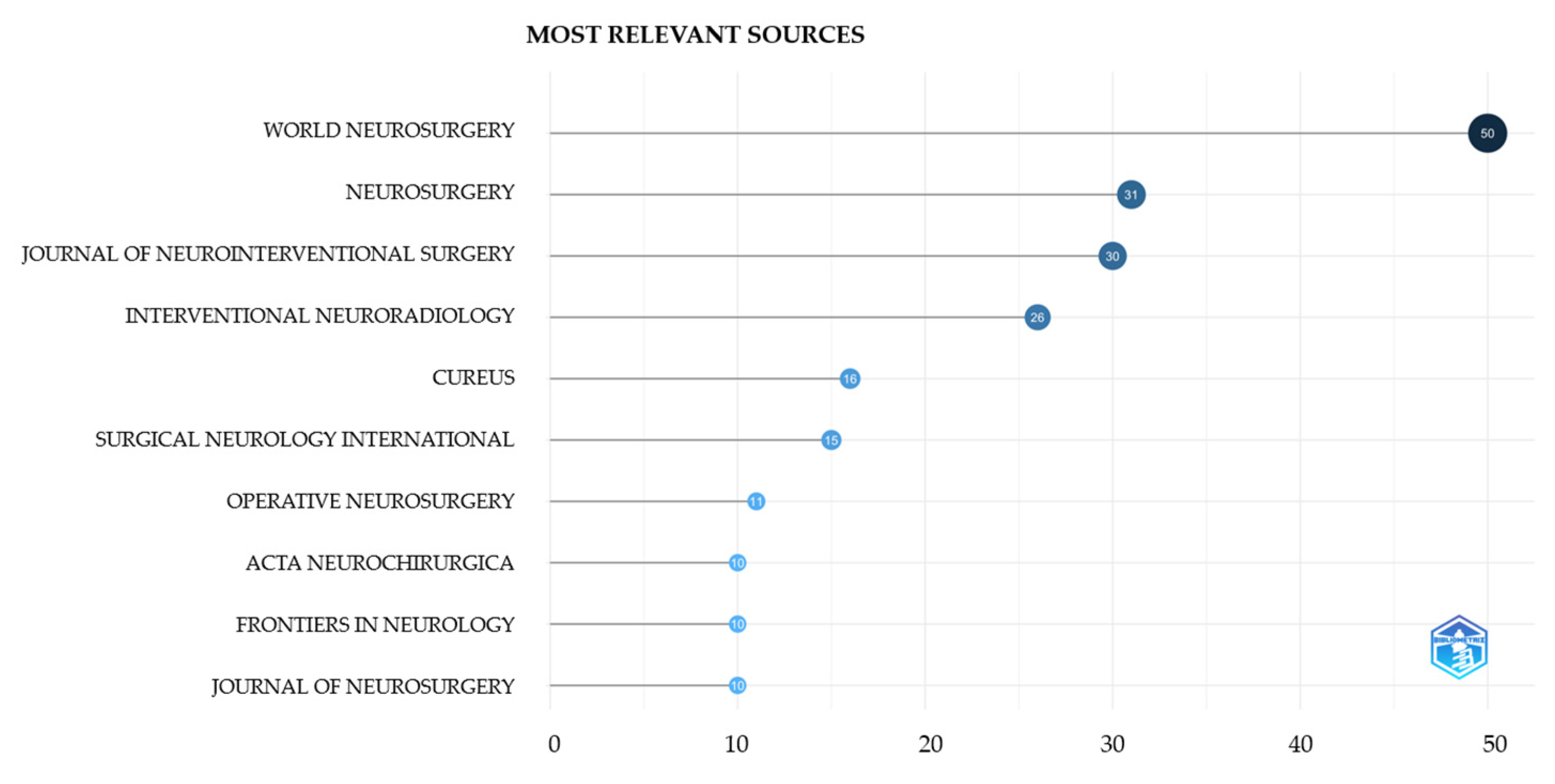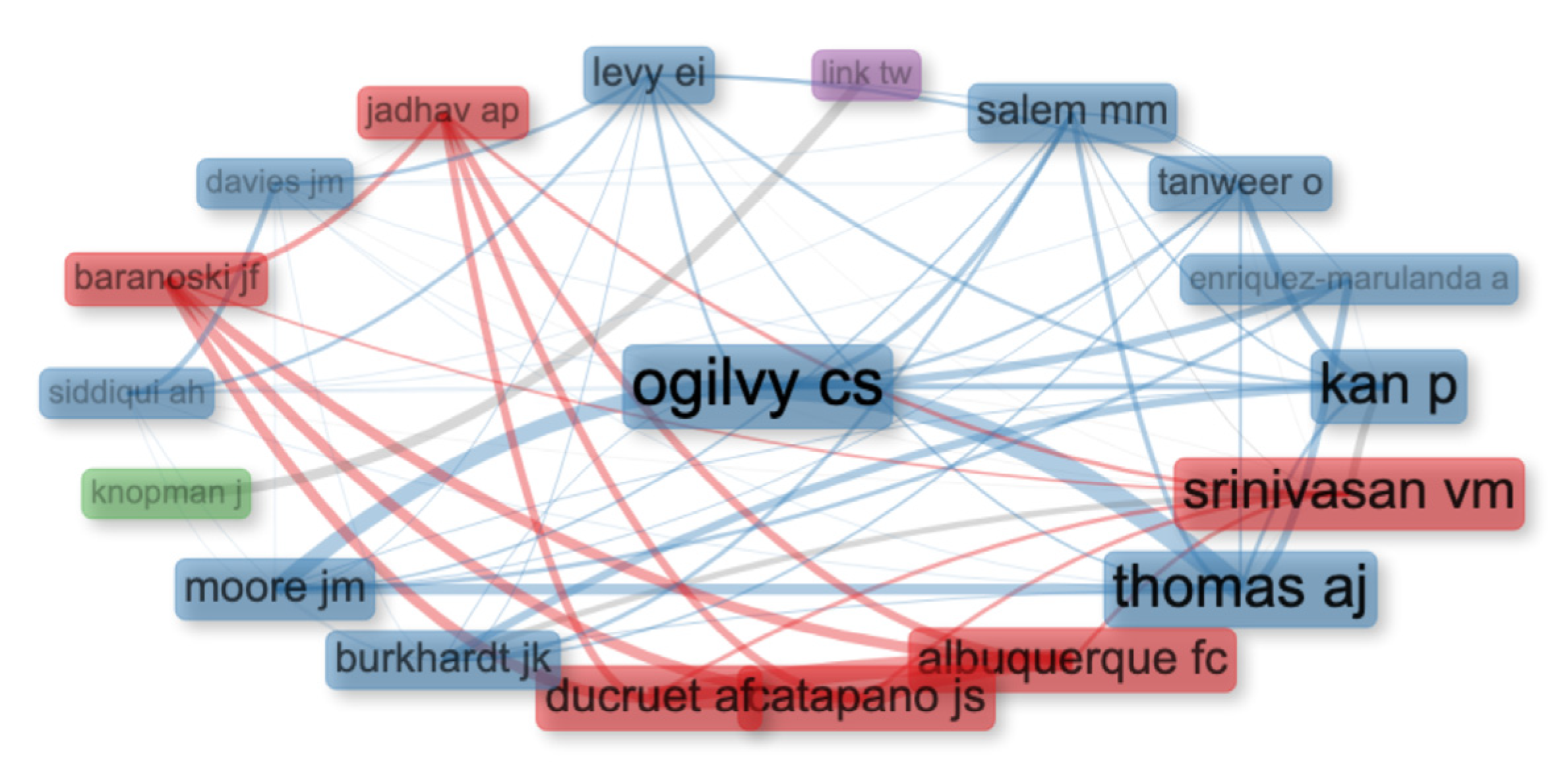Collaboration and Innovation: A Bibliometric Study of the Rise in MMA Embolization in Neurosurgery
Abstract
1. Introduction
1.1. Background
1.2. Objectives
- Assess the trend in publications on embolization for cSDH over the past decade, positioning it as an emerging field.
- Identify leading journals, authors, institutions, and geographic contributors advancing embolization research.
- Examine collaborative networks and thematic focuses within the literature, highlighting areas for future research.
- Outline current evidence gaps and provide recommendations for further study to establish MMA embolization as a validated treatment option for cSDH.
2. Materials and Methods
2.1. Data Source and Search Strategy
- “chronic subdural hematoma” OR “cSDH” AND
- “embolization” OR “endovascular treatment” AND
- “middle meningeal artery” OR “MMA”
2.2. Inclusion and Exclusion Criteria
- Inclusion: Articles discussing embolization techniques for managing cSDH, including case series, observational studies, reviews, and systematic analyses.
- Exclusion: Editorials and non-peer-reviewed articles were excluded to maintain focus on clinically relevant studies with reproducible findings.
2.3. Data Extraction and Bibliometric Indicators
2.4. Data Analysis
3. Results
3.1. Publication Trends
3.2. Geographic Distribution and Institutional Contributions
3.3. Top Journals
3.4. Author Networks and Collaboration Patterns
3.5. Keyword Analysis and Research Themes
4. Discussion
4.1. Summary of Findings
4.2. Interpretation of Trends and Contributions
4.3. Clinical and Research Implications
4.4. Research Gaps and Future Directions
4.5. Limitations
5. Conclusions
Author Contributions
Funding
Institutional Review Board Statement
Informed Consent Statement
Data Availability Statement
Acknowledgments
Conflicts of Interest
Abbreviations
| cSDH | Chronic Subdural Hematoma |
| MMA | Middle Meningeal Artery |
References
- Ironside, N.; Nguyen, C.; Do, Q.; Ugiliweneza, B.; Chen, C.J.; Sieg, E.P.; James, R.F.; Ding, D. Middle meningeal artery embolization for chronic subdural hematoma: A systematic review and meta-analysis. J. Neurointerv. Surg. 2021, 13, 951–957. [Google Scholar] [CrossRef] [PubMed]
- Hanif, H.; Farook, S.; Suriya, S.S.; Gondal, M.U.R.; Bilal, M.I.; Sheikh, A.B. Middle Meningeal Artery Embolization: A Paradigm Shift in Approach of Chronic Subdural Hematoma. J. Community Hosp. Intern Med. Perspect. 2022, 12, 25–35. [Google Scholar] [CrossRef] [PubMed] [PubMed Central]
- Catapano, J.S.; Nguyen, C.L.; Wakim, A.A.; Albuquerque, F.C.; Ducruet, A.F. Middle Meningeal Artery Embolization for Chronic Subdural Hematoma. Front. Neurol. 2020, 11, 557233, Erratum in Front. Neurol. 2021, 12, 666701. https://doi.org/10.3389/fneur.2021.666701. [Google Scholar] [CrossRef] [PubMed] [PubMed Central]
- Srivatsan, A.; Mohanty, A.; Nascimento, F.A.; Hafeez, M.U.; Srinivasan, V.M.; Thomas, A.; Chen, S.R.; Johnson, J.N.; Kan, P. Middle Meningeal Artery Embolization for Chronic Subdural Hematoma: Meta-Analysis and Systematic Review. World Neurosurg. 2019, 122, 613–619. [Google Scholar] [CrossRef] [PubMed]
- Zuo, Q.; Ni, W.; Yang, P.; Gu, Y.; Yu, Y.; Yang, H.; Majoie, C.B.L.M.; Goyal, M.; Liu, J.; Mao, Y.; et al. Managing non-acute subdural hematoma using liquid materials: A Chinese randomized trial of middle meningeal artery treatment (MAGIC-MT)-protocol. Trials 2023, 24, 586. [Google Scholar] [CrossRef] [PubMed] [PubMed Central]
- Aria, M.; Cuccurullo, C. Bibliometrix: An R-tool for comprehensive science mapping analysis. J. Informetr. 2017, 11, 959–975. [Google Scholar] [CrossRef]
- Shankar, J.; Alcock, S.; Milot, G. Embolization of middle meningeal artery for chronic subdural hematoma: Do we have sufficient evidence? Interv. Neuroradiol. 2024, 31, 15910199241246299. [Google Scholar] [CrossRef] [PubMed] [PubMed Central]
- Schmolling, Á.H.; Pérez-García, C.; Trejo, C.; López-Frías, A.; Jaroenngarmsamer, T.; Rosati, S.; Arrazola, J.; Moreu, M. Middle Meningeal Artery Embolization for Management of Chronic Subdural Hematoma. Radiographics 2024, 44, e230158. [Google Scholar] [CrossRef] [PubMed]
- Kan, P.; Maragkos, G.A.; Srivatsan, A.; Srinivasan, V.; Johnson, J.; Burkhardt, J.K.; Robinson, T.M.; Salem, M.M.; Chen, S.; Riina, H.A.; et al. Middle Meningeal Artery Embolization for Chronic Subdural Hematoma: A Multi-Center Experience of 154 Consecutive Embolizations. Neurosurgery 2021, 88, 268–277. [Google Scholar] [CrossRef] [PubMed]
- Ban, S.P.; Hwang, G.; Byoun, H.S.; Kim, T.; Lee, S.U.; Bang, J.S.; Han, J.H.; Kim, C.Y.; Kwon, O.K.; Oh, C.W. Middle Meningeal Artery Embolization for Chronic Subdural Hematoma. Radiology 2018, 286, 992–999. [Google Scholar] [CrossRef] [PubMed]
- Nouri, A.; Gondar, R.; Schaller, K.; Meling, T. Chronic Subdural Hematoma (cSDH): A review of the current state of the art. Brain Spine. 2021, 1, 100300. [Google Scholar] [CrossRef] [PubMed] [PubMed Central]
- Abdelghafar, A.; Falzon, A.; Hendriks, E.J.; Radovanovic, I.; Andrade, H.; Schaafsma, J.D.; Mosimann, P.J. Radiological Outcome of Middle Meningeal Artery Embolization in Relation to Chronic Subdural Hematoma Cause and Architecture. Brain Sci. 2024, 14, 1097. [Google Scholar] [CrossRef] [PubMed]
- Sila, D.; Casnati, F.L.; Vojtková, M.; Kirsch, P.; Rath, S.; Charvát, F. Middle Meningeal Artery Embolization versus Surgery in Patients with Chronic Subdural Hematoma—No More Fence Sitting? Neurol. Int. 2023, 15, 1480–1488. [Google Scholar] [CrossRef] [PubMed]





Disclaimer/Publisher’s Note: The statements, opinions and data contained in all publications are solely those of the individual author(s) and contributor(s) and not of MDPI and/or the editor(s). MDPI and/or the editor(s) disclaim responsibility for any injury to people or property resulting from any ideas, methods, instructions or products referred to in the content. |
© 2025 by the authors. Published by MDPI on behalf of the Swiss Federation of Clinical Neuro-Societies. Licensee MDPI, Basel, Switzerland. This article is an open access article distributed under the terms and conditions of the Creative Commons Attribution (CC BY) license (https://creativecommons.org/licenses/by/4.0/).
Share and Cite
Golubović, J.; Horvat, I.; Djilvesi, D.; Jelača, B.; Vuleković, P. Collaboration and Innovation: A Bibliometric Study of the Rise in MMA Embolization in Neurosurgery. Clin. Transl. Neurosci. 2025, 9, 38. https://doi.org/10.3390/ctn9030038
Golubović J, Horvat I, Djilvesi D, Jelača B, Vuleković P. Collaboration and Innovation: A Bibliometric Study of the Rise in MMA Embolization in Neurosurgery. Clinical and Translational Neuroscience. 2025; 9(3):38. https://doi.org/10.3390/ctn9030038
Chicago/Turabian StyleGolubović, Jagoš, Igor Horvat, Djula Djilvesi, Bojan Jelača, and Petar Vuleković. 2025. "Collaboration and Innovation: A Bibliometric Study of the Rise in MMA Embolization in Neurosurgery" Clinical and Translational Neuroscience 9, no. 3: 38. https://doi.org/10.3390/ctn9030038
APA StyleGolubović, J., Horvat, I., Djilvesi, D., Jelača, B., & Vuleković, P. (2025). Collaboration and Innovation: A Bibliometric Study of the Rise in MMA Embolization in Neurosurgery. Clinical and Translational Neuroscience, 9(3), 38. https://doi.org/10.3390/ctn9030038





